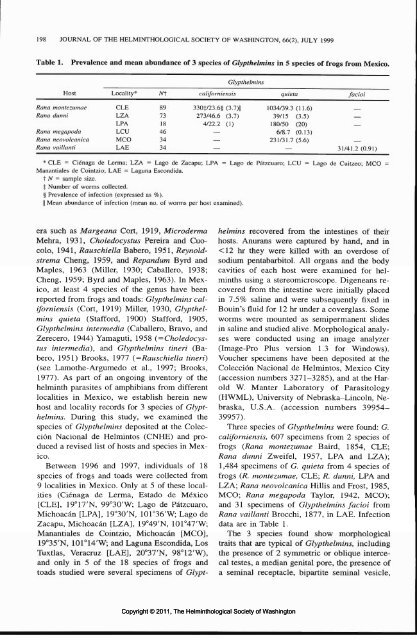The Helminthological Society of Washington - Peru State College
The Helminthological Society of Washington - Peru State College
The Helminthological Society of Washington - Peru State College
Create successful ePaper yourself
Turn your PDF publications into a flip-book with our unique Google optimized e-Paper software.
198 JOURNAL OF THE HELMINTHOLOGICAL SOCIETY OF WASHINGTON, 66(2), JULY 1999<br />
Table 1. Prevalence and mean abundance <strong>of</strong> 3 species <strong>of</strong> Glypthelmins in 5 species <strong>of</strong> frogs from Mexico.<br />
Glypthelmins<br />
califomiensis<br />
Host<br />
Local ity*<br />
Aft<br />
quieta<br />
facioi<br />
Rana montezumae<br />
Rana dunni<br />
Rana megapoda<br />
Rana neovolcanica<br />
Rana vaillanti<br />
CLE<br />
LZA<br />
LPA<br />
LCU<br />
MCO<br />
LAE<br />
89<br />
73<br />
18<br />
46<br />
34<br />
34<br />
330±/23.6§ (3.7)||<br />
273/46.6 (3.7)<br />
4/22.2 (1)<br />
—<br />
—<br />
—<br />
1034/39.3 (11.6)<br />
39/15 (3.5)<br />
180/50 (20)<br />
6/8.7 (0.13)<br />
231/31.7 (5.6)<br />
—<br />
—<br />
—<br />
—<br />
31/41.2 (0.91)<br />
:i: CLE = Cienaga de Lerma; LZA = Lago de Zacapu; LPA = Lago de Patzcuaro; LCU = Lago de Cuitzeo; MCO<br />
Manantiales de Cointzio; LAE = Laguna Escondida.<br />
t N = sample size.<br />
:|: Number <strong>of</strong> worms collected.<br />
§ Prevalence <strong>of</strong> infection (expressed as %).<br />
|| Mean abundance <strong>of</strong> infection (mean no. <strong>of</strong> worms per host examined).<br />
era such as Margeana Cort, 1919, Microderma<br />
Mehra, 1931, Choledocystus Pereira and Cuocolo,<br />
1941, Rauschiella Babero, 1951, Reynoldstrema<br />
Cheng, 1959, and Repandum Byrd and<br />
Maples, 1963 (Miller, 1930; Caballero, 1938;<br />
Cheng, 1959; Byrd and Maples, 1963). In Mexico,<br />
at least 4 species <strong>of</strong> the genus have been<br />
reported from frogs and toads: Glypthelmins califomiensis<br />
(Cort, 1919) Miller, 1930, Glypthelmins<br />
quieta (Stafford, 1900) Stafford, 1905,<br />
Glypthelmins intermedia (Caballero, Bravo, and<br />
Zerecero, 1944) Yamaguti, 1958 (=Choledocystus<br />
intermedia), and Glypthelmins tineri (Babero,<br />
1951) Brooks, 1977 (=Rauschiella tineri)<br />
(see Lamothe-Argumedo et al., 1997; Brooks,<br />
1977). As part <strong>of</strong> an ongoing inventory <strong>of</strong> the<br />
helminth parasites <strong>of</strong> amphibians from different<br />
localities in Mexico, we establish herein new<br />
host and locality records for 3 species <strong>of</strong> Glypthelmins.<br />
During this study, we examined the<br />
species <strong>of</strong> Glypthelmins deposited at the Coleccion<br />
Nacional de Helmintos (CNHE) and produced<br />
a revised list <strong>of</strong> hosts and species in Mexico.<br />
Between 1996 and 1997, individuals <strong>of</strong> 18<br />
species <strong>of</strong> frogs and toads were collected from<br />
9 localities in Mexico. Only at 5 <strong>of</strong> these localities<br />
(Cienaga de Lerma, Estado de Mexico<br />
[CLE], 19°17'N, 99°30'W; Lago de Patzcuaro,<br />
Michoacan [LPA], 19°30'N, 101°36'W; Lago de<br />
Zacapu, Michoacan [LZA], 19°49'N, 101°47'W;<br />
Manantiales de Cointzio, Michoacan [MCO],<br />
19°35'N, 101°14'W; and Laguna Escondida, Los<br />
Tuxtlas, Veracruz [LAE], 20°37'N, 98°12'W),<br />
and only in 5 <strong>of</strong> the 18 species <strong>of</strong> frogs and<br />
toads studied were several specimens <strong>of</strong> Glypthelmins<br />
recovered from the intestines <strong>of</strong> their<br />
hosts. Anurans were captured by hand, and in<br />
















